

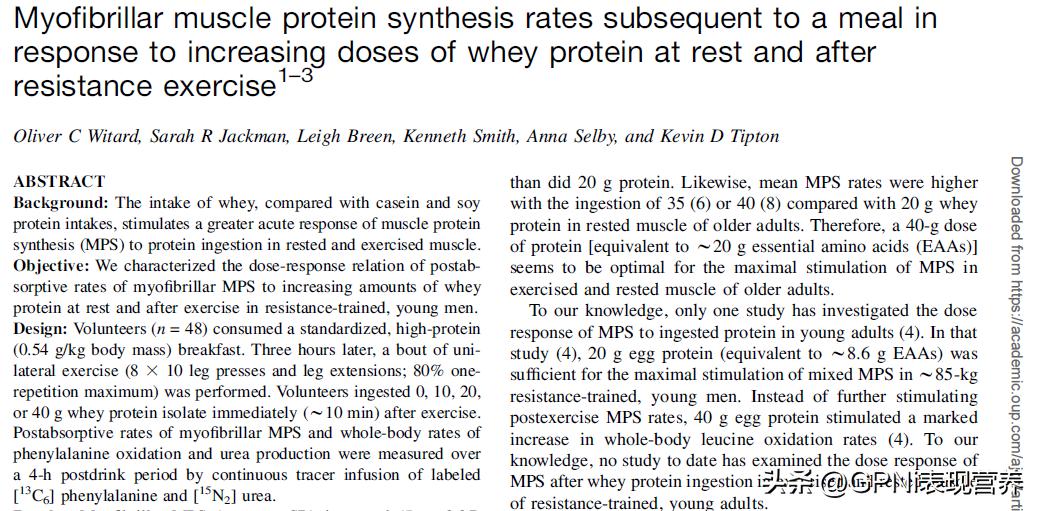
本文节选自论文《Myofibrillar muscle protein synthesis rates subsequent to a meal in response to increasing doses of whey protein at rest and after resistance exercise》(在休息时和抗阻训练后,增加乳清蛋白摄入量,肌肉蛋白合成增加)。
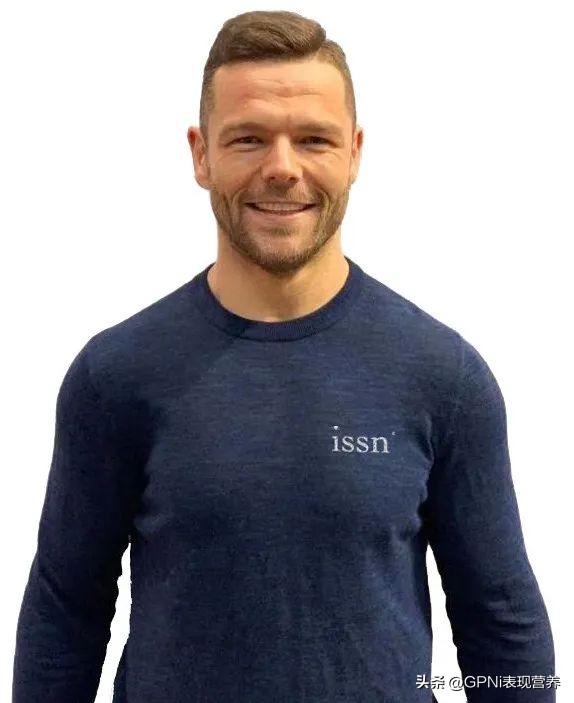
Reid Reale 博士
ISSN运动营养讲师
UFC精英训练中心-运动表现营养经理
注册营养师
高级运动营养师
澳大利亚运动营养师(SDA)成员
佳得乐运动科学研究所(GSSI)-高级科学家
2016年奥运会-AIS首席格斗运动营养师
欧洲体育学院年会-青年研究者奖
BJJ巴西柔术黑带一段
名词解释:
MPS:Muscle Protein Synthetise 肌肉蛋白合成
RM:Repetition Maximum 最大重复值
WP:Whey Protein 乳清蛋白(10WP-10克乳清蛋白)
AUC:Area Under Curve ROC曲线下与坐标轴围成的面积
FSR:Fractional Synthesis Rate 蛋白质部分合成率
EAA:Essential Amino Acid 必需氨基酸
摘 要
ABSTRACT
1、背景 Background
与酪蛋白和大豆蛋白相比,在休息时和锻炼后,乳清蛋白的摄入会刺激肌肉蛋白合成(MPS),产生更大的急性反应。
The intake of whey, compared with casein and soy protein intakes, stimulates a greater acute response of muscle protein synthesis (MPS) to protein ingestion in rested and exercised muscle.
2、目标 Objective
我们对接受抗阻训练的年轻男性,在休息时和运动后的肌原纤维MPS吸收率与乳清蛋白含量增加的剂量-反应关系进行了研究。
We characterized the dose-response relation of postabsorptive rates of myofibrillar MPS to increasing amounts of whey protein at rest and after exercise in resistance-trained, young men.
3、设计 Design
48位志愿者摄入标准的高蛋白(0.54克/公斤体重)早餐。3小时后进行一次单侧运动(8×10腿举和腿屈伸;80%1RM)。志愿者在运动后立即(约10分钟)摄入0、10、20或40克乳清蛋白分离物。在摄入后的4小时内,通过连续示踪输注标记的苯丙氨酸和尿素,测定了肌原纤维MPS的吸收率和全身苯丙氨酸氧化率和尿素生产率。
Volunteers (n = 48) consumed a standardized, high-protein (0.54 g/kg body mass) breakfast. Three hours later, a bout of unilateral exercise (8 × 10 leg presses and leg extensions; 80% one-repetition maximum) was performed. Volunteers ingested 0, 10, 20, or 40 g whey protein isolate immediately (∼10 min) after exercise. Postabsorptive rates of myofibrillar MPS and whole-body rates of phenylalanine oxidation and urea production were measured over a 4-h postdrink period by continuous tracer infusion of labeled [13C6] phenylalanine and [15N2] urea.
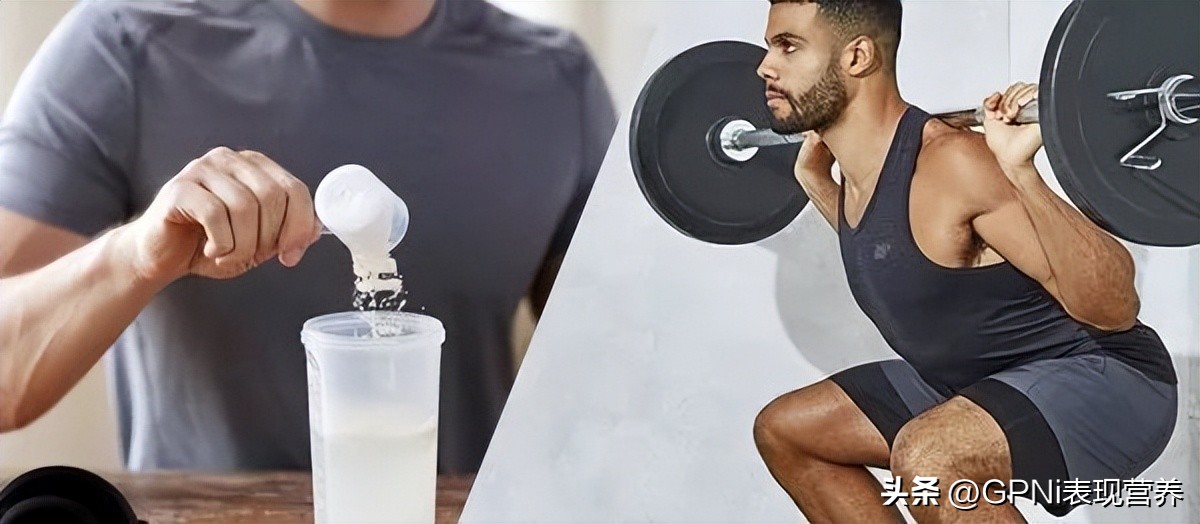
▲ 图片源于网络
4、结果 Result
当摄入20和40克乳清蛋白时,肌纤维MPS分别增加49%和56%,而当摄食10克乳清蛋白时,没有观察到额外的刺激。随着乳清蛋白的摄入量的增加,苯丙氨酸氧化率和尿素产量增加。
Myofibrillar MPS (mean ± SD) increased (P < 0.05) above 0 g whey protein (0.041 ± 0.015%/h) by 49% and 56% with the ingestion of 20 and 40 g whey protein, respectively, whereas no additional stimulation was observed with 10 g whey protein (P > 0.05). Rates of phenylalanine oxidation and urea production increased with the ingestion of 40 g whey protein.
5、结论 Conclusions
20克乳清蛋白足以最大程度刺激80公斤抗阻训练的年轻男性,休息和锻炼后的肌原纤维MPS吸收率。大于20克乳清蛋白会刺激氨基酸氧化和尿素生成。
A 20-g dose of whey protein is sufficient for the maximal stimulation of postabsorptive rates of myofibrillar MPS in rested and exercised muscle of ∼80-kg resistance-trained, young men. A dose of whey protein >20 g stimulates amino acid oxidation and ureagenesis.
引 言
INTRODUCTION
研究已经调查了蛋白质摄入的最佳剂量,以最大限度地刺激老年人和年轻人运动和休息时的MPS。在老年人中,40克乳清或大豆蛋白比20克更能刺激MPS。因此,40克剂量的蛋白质(相当于约20克必需氨基酸)似乎是最大程度刺激老年人锻炼和休息时MPS的最佳方法。
但只有一项研究调查了年轻人MPS对蛋白质的摄入量反应。在该研究中,20克鸡蛋蛋白(相当于约8.6克EAAs)足以满足MPS(约85公斤抗阻训练的年轻男性)的最大刺激。40克鸡蛋蛋白并没有进一步的刺激,反而增加了全身亮氨酸氧化率。到目前为止,还没有一项研究调查训练后和休息中的年轻人摄入乳清蛋白后MPS的剂量反应。
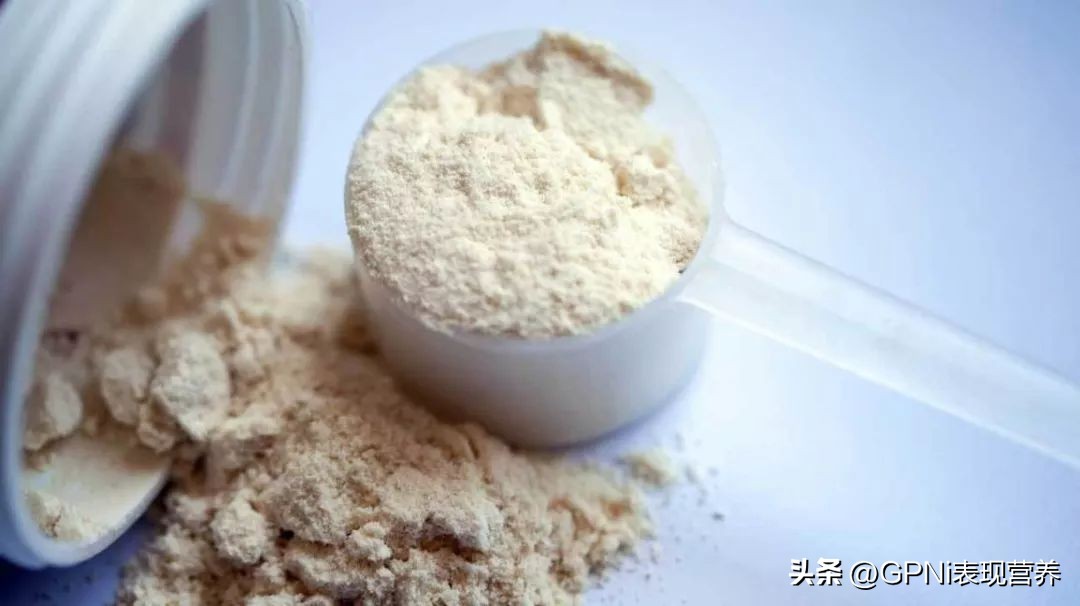
▲ 图片源于网络
研究表明,剧烈抗阻训练增强了MPS水平,这种MPS早在早餐中就已经被富含蛋白质的食物所激发。因此,在进食后1小时进行运动时,就可以检测到运动诱导的MPS增强。此外,抗阻训练主要刺激与肌肥大相关的肌原纤维蛋白的合成。因此,重要的是描述肌原纤维的剂量-反应关系,而不是混合MPS率和摄入的蛋白质剂量。
省略研究对象和研究方法内容,主要包括研究设计、身体指标测量、血液和肌肉等数据统计分析与计算......
结 果
RESULTS
1、葡萄糖和胰岛素浓度的剂量反应变化
Dose-response changes in glucose and insulin concentrations
所有情况下的血糖浓度基线都相似,早餐后血糖浓度也有类似的升高,在每次摄入后2小时血糖浓度又恢复到基线水平。
基线胰岛素浓度在不同条件下无差异。在0g乳清蛋白状态下,胰岛素在运动后30分钟恢复到基线值,并在整个恢复期保持稳定。胰岛素在摄入乳清蛋白30分钟后达到峰值,并分别在60分钟(10WP、20WP)和90分钟(40WP)内高于摄入前的量。4小时内,40WP组的胰岛素AUC最大。
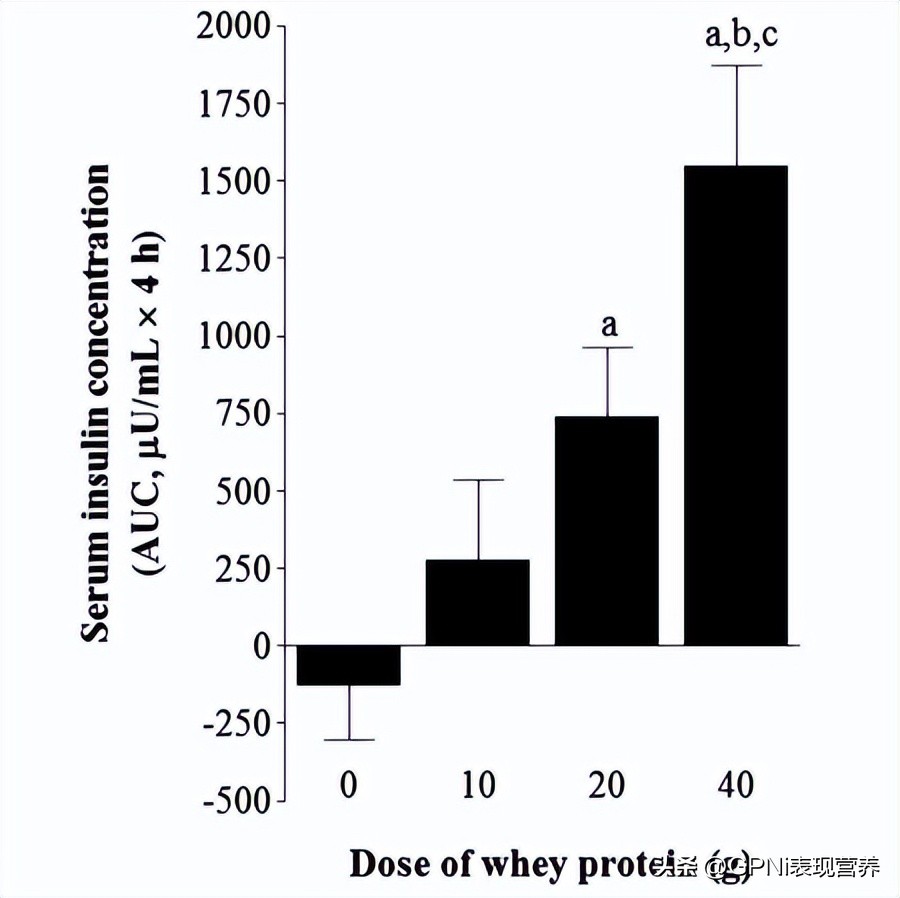
▲ 胰岛素剂量反应变化
2、氨基酸浓度的剂量反应变化
Dose-response changes in amino acid concentrations
在所有剂量条件下,早餐后氨基酸浓度都有相似程度的增加。运动将苯丙氨酸和亮氨酸的浓度降低到所有条件下的基线浓度,此后0WP组没有变化。摄取乳清蛋白后苯丙氨酸和亮氨酸浓度迅速升高,并在摄入后30分钟(10WP和20WP)或60分钟(40WP)达到峰值。
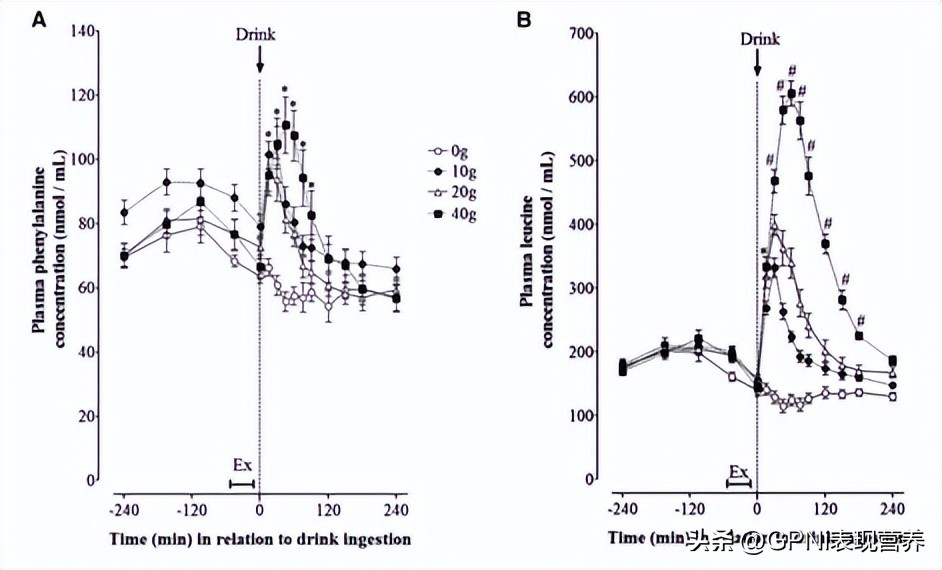
▲ 血浆苯丙氨酸、亮氨酸剂量反应变化
3、苯丙氨酸全身氧化率的剂量反应变化
Dose-response changes in whole-body phenylalanine oxidation rates
苯丙氨酸氧化速率在0WP、10WP和20WP之间没有观察到差异。在40WP中苯丙氨酸的氧化速率高于其他条件。
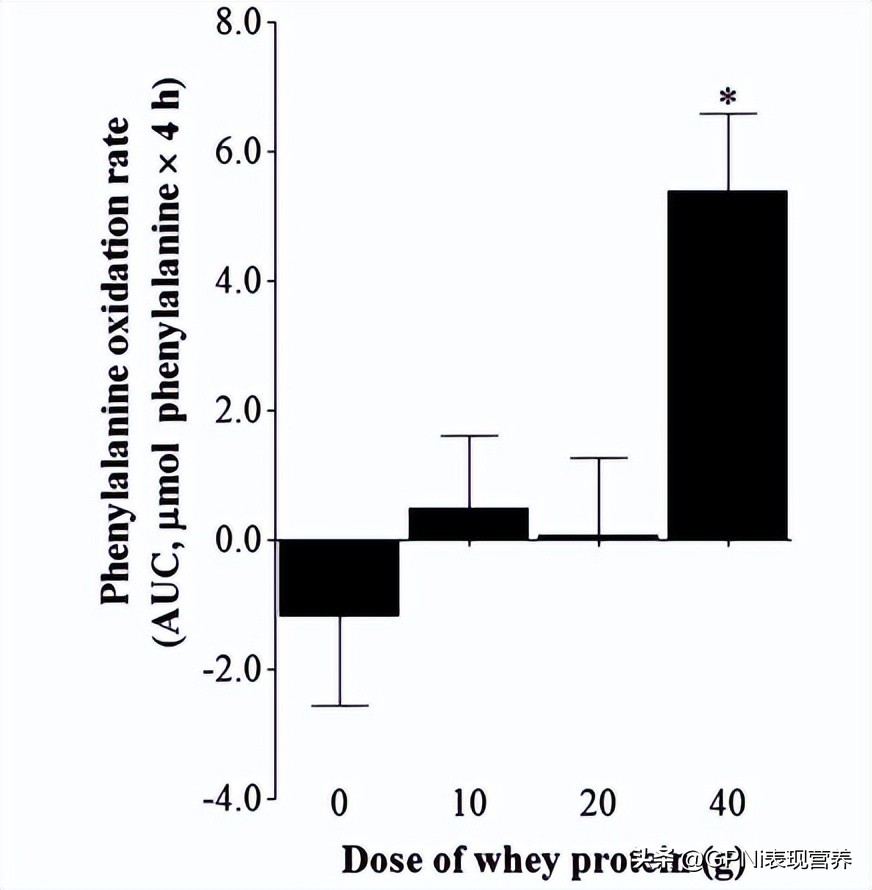
▲ 苯丙氨酸氧化率剂量反应变化
4、全身尿素产生率和血浆浓度的剂量反应变化
Dose-response changes in whole-body urea production rates and plasma concentrations
乳清蛋白摄入后(10WP、20WP和40WP)的尿素产量大于0WP,而40WP的尿素产量AUC显著大于10WP,并有大于20WP的趋势。40WP的血浆尿素浓度大于0WP、10WP、20WP;20WP和10WP的血浆尿素浓度大于0WP。
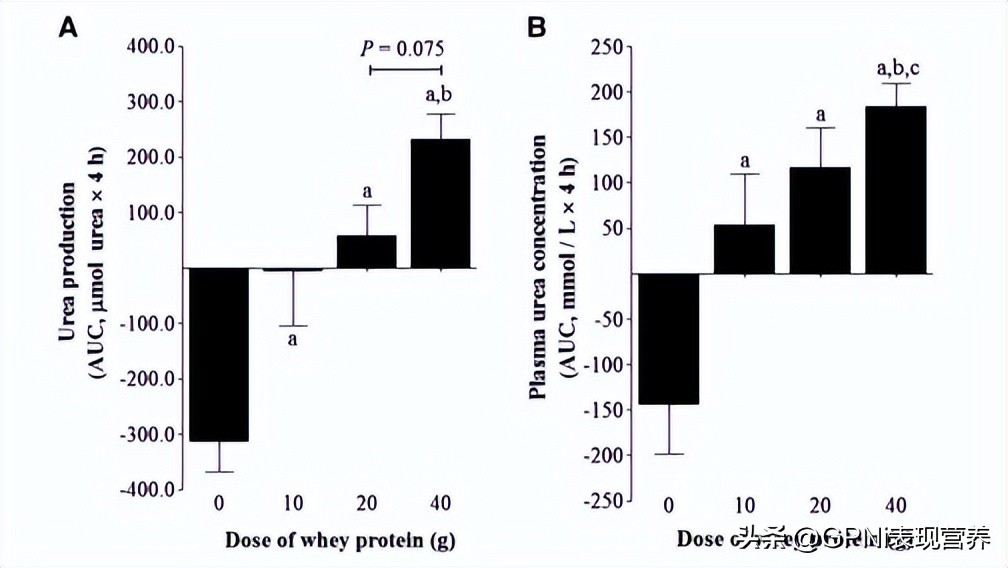
▲ 尿素、血浆尿素剂量反应变化
5、肌原纤维MPS率的剂量反应变化
Dose-response changes in myofibrillar MPS rates
总的来说,在所有剂量条件下,运动组的肌纤维FSR高于非运动组。在20WP和40WP中,肌纤维FSR比0WP组分别增加了~49%和~56%,而0WP和10WP之间没有观察到差异。此外,在10WP基础上,肌纤维FSR在20WP和40WP分别增加了~22%和~28%。20WP和40WP之间的肌纤维MPS无差异。
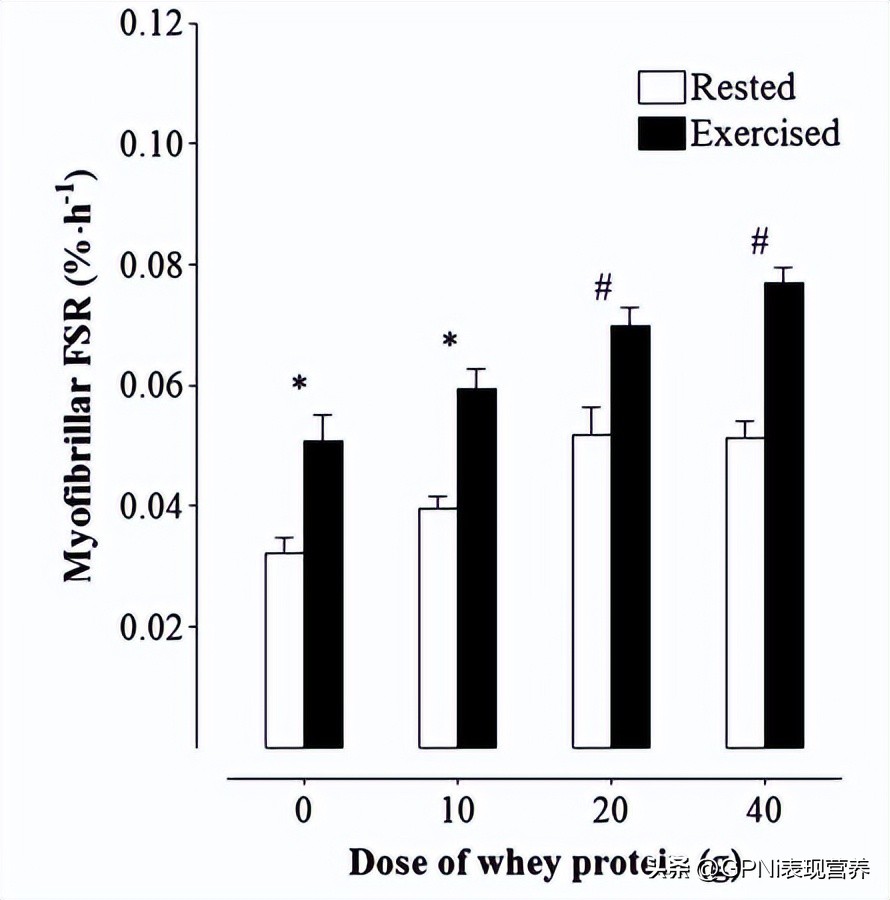
▲ 肌纤维FSR剂量反应变化
讨 论
DISCUSSION
在吸收后,中剂量(20克)和高剂量(40克)乳清蛋白的摄入比低剂量(10克)乳清蛋白更能刺激肌纤维MPS的反应。然而,摄入20克乳清蛋白,肌纤维MPS达到上限。因此,在这个人群,约80公斤的训练过的年轻男性群体中,40克乳清蛋白并没有进一步提高肌纤维MPS的吸收后率,反而导致了全身氨基酸分解代谢指标率的显著增加;摄入40g乳清蛋白后氨基酸氧化增加明显增加,摄入20-40g乳清蛋白后尿素分泌增多。
The postabsorptive ingestion of moderate (20 g) and high (40 g) doses of whey protein stimulated a greater response of myofibrillar MPS than with the low (10 g) dose of whey protein. However, myofibrillar MPS reached an upper limit with the ingestion of 20 g whey protein. Hence, in this population of ∼80-kg trained, young men, 40 g whey protein failed to further augment postabsorptive rates of myofibrillar MPS and, instead, elicited a marked increase in the rate of indicators of whole-body amino acid catabolism; the increase in amino acid oxidation was markedly greater with the ingestion of 40 g whey protein, and ureagenesis was greater with the ingestion of 20–40 g whey protein.
本研究主要的新发现是,在吃完一顿富含蛋白质(约45 g)的早餐后4小时(3小时45分钟)的肌纤维MPS比率,通过摄入20克乳清蛋白达到最大值。因此,对于80-85公斤的年轻男性,无论在禁食还是吸收后状态摄入单一剂量的氨基酸,20 克蛋白质(约10克EAAs)对于在休息或运动后刺激MPS最有效。MPS对年轻人摄入酪蛋白或低质量蛋白(如大豆)的剂量反应尚不清楚,但至少在定性上,它可能反映了蛋白质来源的EAA组合物(特别是亮氨酸)。
Hence, the primary novel finding of this study was that 4-h myofibrillar MPS rates, measured after (3 h 45 min) a protein-rich (∼45 g) breakfast, were maximized by ingesting a 20-g dose of whey protein. Hence, irrespective of whether a single bolus dose of amino acids is ingested in the fasted or postabsorptive state, a dose of 20 g protein (equivalent to ∼10 g EAAs) is maximally effective for stimulating MPS at rest or postexercise in 80–85-kg young men. The dose response of MPS to ingested casein or lower-quality protein, such as soy, in young adults remains unknown but likely mirrors, at least qualitatively, the EAA composition (in particular of leucine) of protein sources.
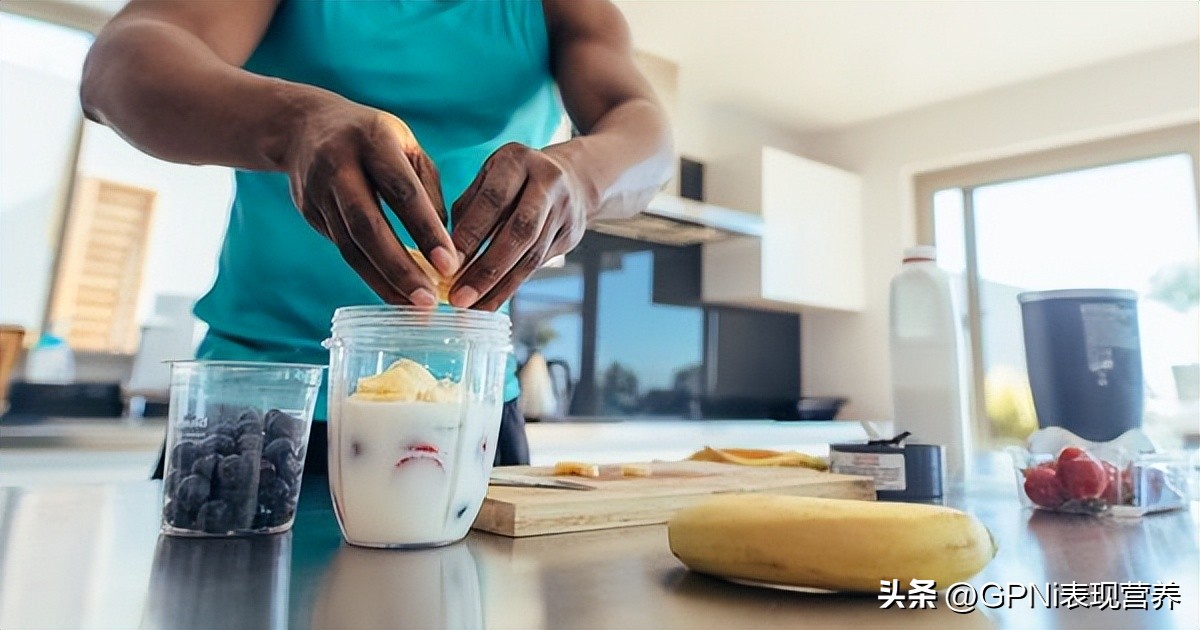
▲ 图片源于网络
这些数据对那些渴望增加肌肉质量或保持肌肉的人群显示了明确的临床意义。对于80-85公斤抗阻训练的年轻男性来说,过去和现在的数据表明,反复摄入大于20克的蛋白质,MPS急性运动后刺激率会降低。相比之下,40WP中高出的10-14%MPS对肌肥大的长期生理影响尚不清楚。此外,最大化MPS的最佳蛋白质剂量可能取决于个体的肌肉质量。120公斤体重的运动员、80公斤体重的男性运动者与60公斤体重的女性运动者之间,是否存在最大程度刺激MPS的最佳蛋白质剂量的差异,目前尚不清楚。营养建议不仅应该针对个人的年龄,还应该针对个人的瘦体重、性别和训练状况。
These data exhibited clear clinical implications to populations who desire muscle-mass gain or muscle maintenance. For 80–85-kg resistance-trained, young men, past and current data suggested that a diminished return in terms of the acute stimulation of postexercise rates of MPS is gained from repeatedly ingesting >20 g protein. In contrast, the long-term physiologic impact of a 10–14% higher rate of MPS in the 40WP on muscle hypertrophy remains unknown. Furthermore, it is possible that the optimal dose of protein for maximizing MPS depends on individual muscle mass. It remains unknown whether the optimal dose of protein for the maximal stimulation of MPS differs between the 120-kg athlete and 80-kg male exerciser compared with the 60-kg female exerciser. It is intuitive that nutritional recommendations should be specified not only to the individual’s age but also to the lean body mass, sex, and training status of the individual.
总之,年轻男性(约80公斤)肌纤维MPS的吸收后反应依赖于蛋白质摄入量,20克乳清蛋白使其最大化。大于20克乳清蛋白,在刺激肌纤维MPS方面效果下降,而且刺激氨基酸氧化和尿素生成。
In conclusion, the postabsorptive response of myofibrillar MPS in ∼80-kg resistance-trained, young men are dose-dependent on ingested protein, rising to an upper limit with 20 g whey protein. The ingestion of a dose of whey protein >20 g results in a diminished return in terms of stimulating myofibrillar MPS and, instead, stimulates amino acid oxidation and ureagenesis.
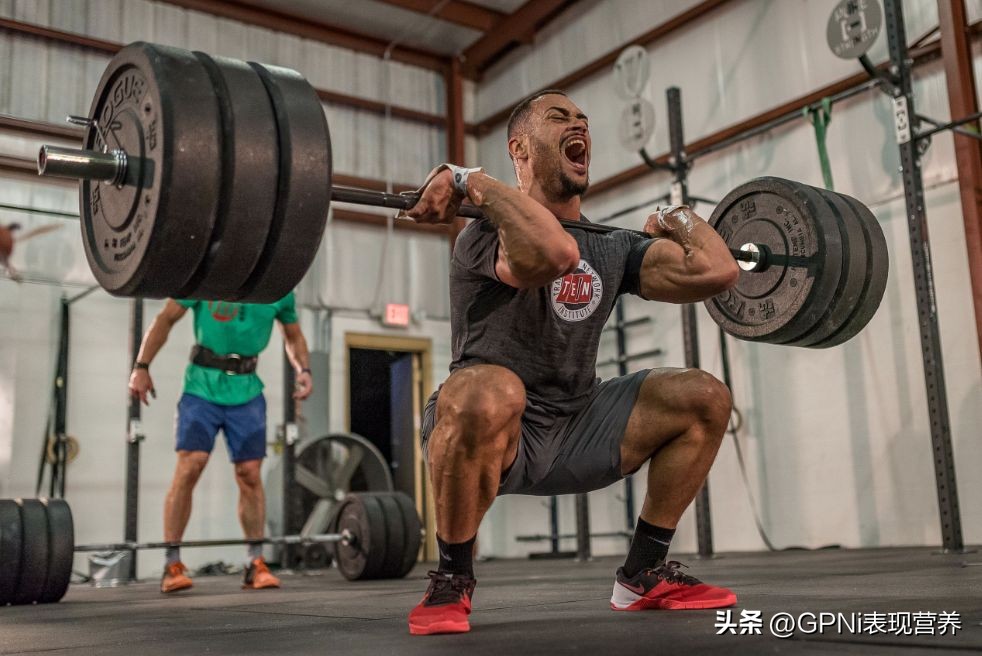
▲ 图片源于网络
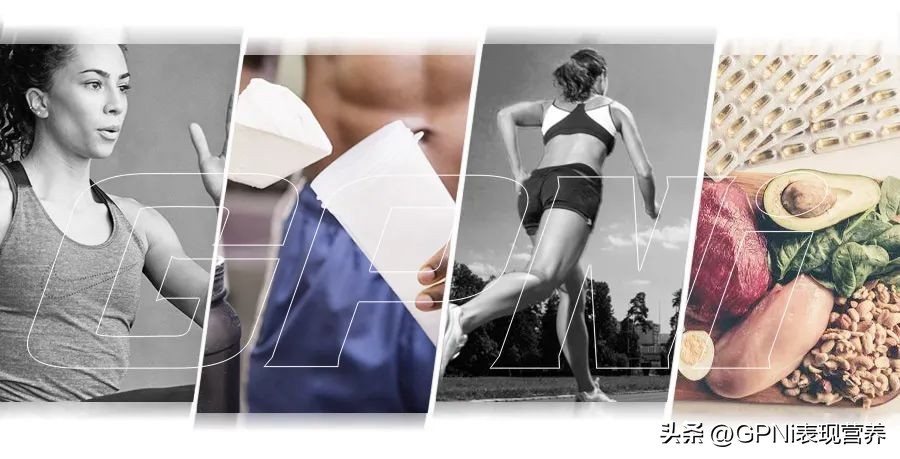

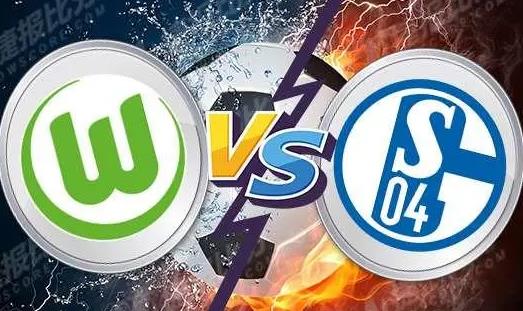
 [13:45] 瑞德兰茨联U23 VS 半岛电力U23
[13:45] 瑞德兰茨联U23 VS 半岛电力U23







 京多安:莱比锡是支顶级球队,我们应表现出最好状态
京多安:莱比锡是支顶级球队,我们应表现出最好状态